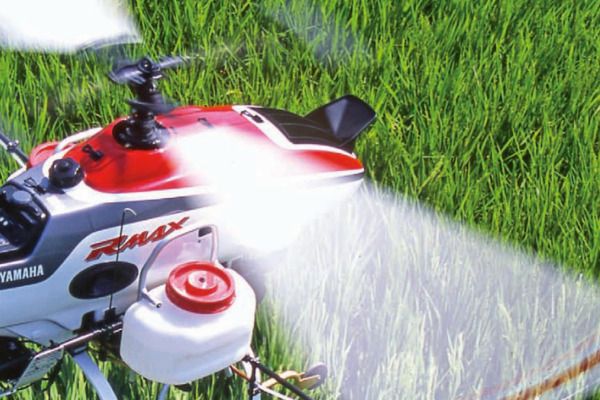“I’ll tell you the story,” Sen. Dianne Feinstein said at Wednesday’s Senate Commerce Committee hearing on mainstreaming domestic uses of drones, “of there being a demonstration in front of my house. And so I went to the window to peek out and see who was there. And there was a drone, right there, at the window, looking at me.”
“Obviously the pilot of the drone had some surprise, because the drone wheeled around and crashed,” she went on. “So I felt a little good about that.”
Feinstein’s mixed emotions — she tends to supports domestic drones, especially since many drone companies are based in her state of California — mirror the national approach to the use of unmanned aircraft over U.S. soil. The Federal Aviation Administration has been criticized for moving too slowly on drones, while countries like the U.K. and Japan long ago okayed their use for everything from fertilizing crops to delivering take-out to examining bridges and pipelines up close. The U.S. largely pioneered the technology that drives drones, but right now the approval process for using them here is largely bespoke. Running a commercial or even law enforcement drone, the senators heard, requires a one-off FAA permit.
It was only last year, in fact, that the U.S. issued its very first permit for a commercial drone, for surveying vehicle marine animals off the coast of Alaska. When Congress passed the FAA Modernization and Reform Act of 2012, it said that the agency must figure out how to safely and holistically integrate unmanned aircraft systems into U.S. airspace. This week’s hearing was something of a progress report. Dr. Missy Cummings, director of the Humans and Autonomy Laboratory at Duke’s Institute for Brain Science, said that things are still taking too long.
The country, Cummings said, “is not leading the commercial drone industry. It’s lagging.” Amazon’s recent announcement about drone package delivery was appreciated, according to Cummings, but “there are companies in China and Australia that beat them to the punch.”
Cities present their own challenges to drone use, including the congestion that leads to contested air space. The FAA recently announced six test sites meant to try out unmanned aircraft in a variety of geographies. The test projects are meant to address the Catch-22 of unmanned aircraft: Thanks to the tight leash that the FAA has kept on drones, there’s little data available on whether that tight leash is justified.
In the meantime, observers have drawn their own conclusions. “On average, a drone is a better pilot than I am,” said Cummings, who flew F/A-18 Hornets for the U.S. Navy. She was joined at the witness table by Henlo Arcangeli, a representative from Yamaha who showed a video demonstrating how the company’s $100,000 RMAX drone is used, without incident, to spread fertilizer and nutrients on crops in Japan. It’s been 20 years since the Japanese government came to Yamaha and asked for help in figuring out precision agriculture, Arcangeli said. He concluded, “We believe that at least some of these products should be available to American farmers today.”
Arcangeli made sure the senators heard that the nimble drone’s engine on tape sounded like one of the company’s other products: a motorcycle. “It’s not going to sneak up on anybody unexpectedly,” he said. But the privacy issues raised by drones’ remarkable ability to dip and weave aren’t easily dismissed. Feinstein called for “strong, binding and enforceable privacy policies.” For their part, the test site operators are required to have written policies on privacy and plans on data detention.
FAA Administrator Michael Huerta, meanwhile, told the senators that the agency expects to see 7,500 drones added to U.S. airspace in the next five years. Chris Calabrese, legislative counsel from the American Civil Liberties Union, testified that we’ve grown used to having a “natural limit” to the surveillance risks of aircraft, mostly because planes are expensive. Cheap drones, though, put the ACLU in a tight spot. On the one hand, civil libertarians don’t want any sort of clamping down on drone photography just because it’s novel. But the very novelty of drones means that they might upset a delicate balance, because people are newly aware they could, possibly, be under surveillance.
“Studies have shown,” Calabrese said, “that merely hanging posters of the human eye is enough to significantly change people’s behavior.”
Calabrese had just, he said, come from watching footage from a blimp camera capable of recording the actions of a medium-sized city: “Everyone in that city can be videotaped at one time. You can zoom in and identify particular individuals to the extent that you can literally see them move their arms.” He went on: “That type of detailed tracking, I think, is foreign to the American idea that we should be essentially left alone if we haven’t done anything wrong.” The committee’s lead Democrat, Jay Rockefeller, echoed this point: “The Brits are very accustomed to being, I think, taped 346 times a day. They just accept that. That’s part of their life. It isn’t part of ours. We don’t think it is.”
That, and we live in the Edward Snowden era, which means there will be plenty of pondering and palavering about drone privacy. But the technology’s merits and the makeup of Congress both suggest a quick loosening of the rules. The Senate is especially amenable to the needs of farmers, and ag is one of the biggest uses for commercial drones today. Rockefeller, from West Virginia, and Ranking Member John Thune of South Dakota represent a grand total of 3 million people, or about the population of Chicago. Rockefeller mused about the excitement surrounding “Jeff Bezos delivering Amazon packages right to John Thune’s doorstep.”
Thune shot back that when it comes to South Dakota, it isn’t contested airspace that drones have to worry about: “The real test of the design of these systems is whether or not they can continue to operate at 50 below windchill.”
Related: Should drones have license plates?

Nancy Scola is a Washington, DC-based journalist whose work tends to focus on the intersections of technology, politics, and public policy. Shortly after returning from Havana she started as a tech reporter at POLITICO.








